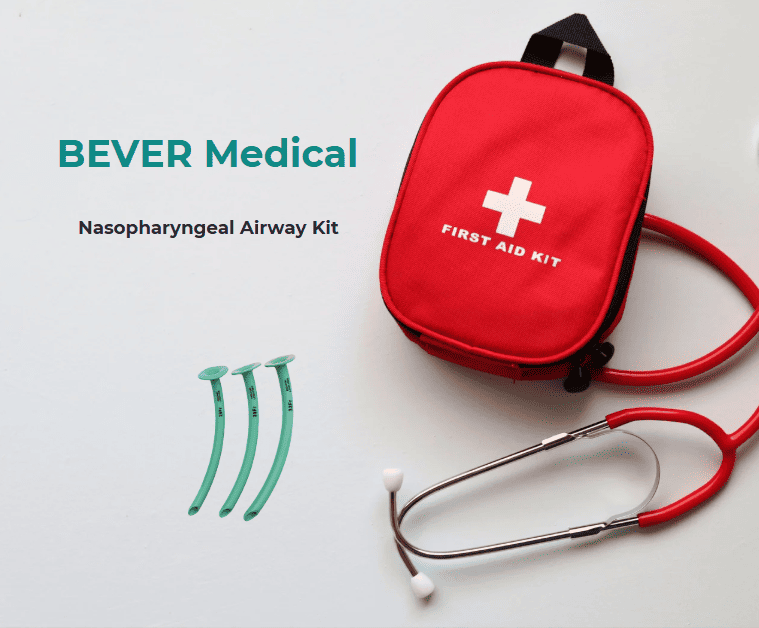TEl: +86-13148388090
Fax:+86-571-88616515
Nasopharyngeal Airway Kit in Wilderness First Aid: How to Use It and Choose the Right One
Author: admin / 2025-07-05In remote locations where medical support is miles—or hours—away, having the right tools can mean the difference between life and death. A nasopharyngeal airway kit is one of the most essential components in any well-stocked wilderness or tactical first aid pack. Designed to maintain an open airway in unconscious or semi-conscious patients, this simple yet effective device is a cornerstone of emergency airway management—especially when jaw trauma, clenched teeth, or limited access makes oral airways unfeasible.

But knowing how to use it is only half the equation. Choosing the right material and size for your nasopharyngeal airway (NPA) is just as critical. In this guide, we explore why the NPA kit is indispensable in field conditions and how to select the most suitable type for your needs.
Why Use a Nasopharyngeal Airway Kit in Field Emergencies?
When someone becomes unconscious—due to trauma, heat exhaustion, low oxygen, seizure, or cardiac arrest—their tongue may relax and block the airway. In such situations, quick insertion of an NPA can:
- Prevent airway obstruction
- Support spontaneous breathing
- Buy time until advanced help arrives
- Avoid unnecessary intubation attempts
In outdoor settings where dust, dirt, and debris can complicate airway access, NPAs are favored for their ease of insertion and minimal need for head positioning. They are particularly valuable in environments where cervical spine injury is suspected, and head-tilt maneuvers must be avoided.
What's in a Nasopharyngeal Airway Kit?
A standard field-ready NPA kit typically includes:
- A soft, pre-lubricated or lubricated nasopharyngeal airway tube
- Sterile, water-soluble lubricant
- Optional: gloves and alcohol wipes
- Compact, sterile packaging that fits easily in an IFAK or field pouch
Many kits come pre-lubricated or include a lubricant sachet, ensuring smooth insertion even under high-stress conditions.
Choosing the Right Material: PVC vs. Silicone vs. Latex-Free
There is no one-size-fits-all NPA, especially when considering comfort, flexibility, and environmental adaptability. Here's how to decide:
PVC (Polyvinyl Chloride)
- Pros: Cost-effective, slightly firm for easier insertion
- Best for: Single-use, rugged environments where durability matters
- Caution: May become stiff in cold weather; check if latex-free if needed
Silicone
- Pros: Ultra-soft, biocompatible, maintains flexibility in cold temperatures
- Best for: Reusable settings, sensitive patients, cold weather or altitude use
- Caution: Typically more expensive
Latex-Free NPAs
- Pros: Safe for patients with latex allergies, compliant with hospital and military standards
- Best for: Broad use without allergy risk
- Caution: Check materials if not explicitly marked as latex-free
For field kits used in cold climates or tactical operations, silicone NPAs offer better flexibility and reduced patient discomfort. For mass-distribution or civilian IFAKs, PVC versions are a practical and economical choice.
Choosing the Right Size
Selecting the correct NPA size is essential for both efficacy and safety. Improper sizing may lead to inadequate ventilation or nasal trauma.
Sizing by Diameter
Most NPAs are sized using internal diameter (ID) in millimeters, typically ranging from 6.0mm to 9.0mm for adults.
- 6.0mm – 6.5mm: Small adults or females
- 7.0mm – 7.5mm: Average adult males
- 8.0mm – 9.0mm: Larger adult males or tactical use
Sizing by Length
The tip should reach just above the epiglottis. A quick field method:
Measure from nostril to earlobe. This gives a rough idea of appropriate length.
Tip: Always carry multiple sizes in your kit. One size does not fit all, especially in variable environments.
Field Application Tips
- Apply lubricant generously unless pre-lubricated
- Insert the NPA with the bevel toward the nasal septum
- If resistance is met, try the other nostril
- Never force the airway—if blocked, reassess or use an oral alternative
For untrained users, the NPA is easier and safer to use than oral airways or supraglottic devices. That's why it's favored in military, outdoor rescue, and pre-hospital care scenarios.
Final Thoughts: A Must-Have for Every Field Medic or Adventurer
Whether you're a wilderness medic, military responder, search-and-rescue volunteer, or just an outdoor enthusiast preparing for emergencies, a nasopharyngeal airway kit is a lightweight yet lifesaving investment.
Easy to use
Effective in trauma and unconsciousness
Small enough for every first aid pouch
Need High-Quality NPA Kits in Bulk?
We offer OEM services, military-grade packaging, and international shipping with CE, FDA, and ISO13485 certifications.
Contact us today to request free samples or bulk pricing tailored to your region and field requirements.


